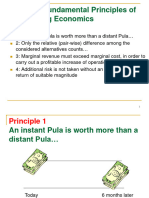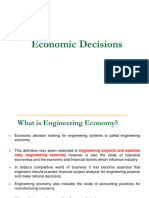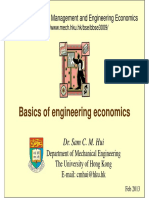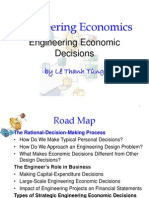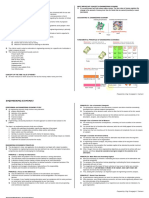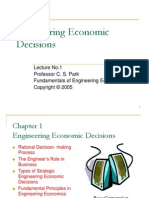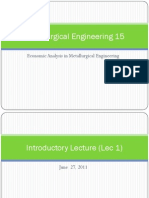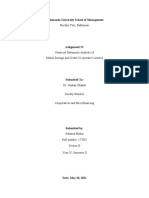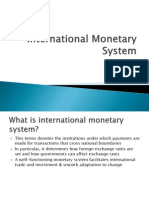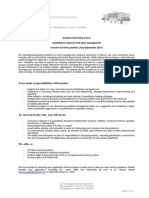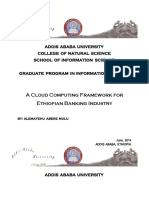Engineering Economics
Lecture No.1
1
�Text Book
◼ Engineering Economics by R. Panneerselvam (Second
Edition)
2
�Engineering Economics
◼ Contents of this course is centered to:
“Time Value of Money”
i.e value of money changes with time.
And its is important in “ DECISION MAKING”
3
�ENIGINEERING
◼ Profession in which knowledge of mathematical and
social sciences gained by study, experience and
practice is applied with judgment to develop ways to
utilize, economically, the materials and forces of
nature for the benefit of mankind.
4
�ECONOMICS…..
◼ Study of how limited resources are used to
satisfy unlimited human wants.
5
�6
�7
�8
�Engineering Economics
◼ Previously known as engineering economy,
is a subset of economics concerned with the
use and "...application of economic
principles“ in the analysis of engineering
decisions.
9
�Characteristics of Engineering Projects
◼ Cost – High Cost
◼ Time – Long time to complete
◼ Complexity
◼ Uncertainty – Long time to complete
-- Economic Conditions
10
� Engineering Economics
Overview
• Rational Decision-Making Process
• Economic Decisions
• Predicting Future
• Role of Engineers in Business
• Large-scale engineering projects
• Types of strategic engineering economic
decisions
11
�Rational Decision Making Process
◼ Individual use analysis, facts and a step by
step process to come to a decision.
◼ Precise and analytical process
◼ Used by companies to come up with fact
based decisions.
12
�Rational Decision-Making Process
1. Recognize a decision
problem
2. Define the goals or
objectives
3. Collect all the relevant
information
4. Identify a set of feasible
decision alternatives
5. Select the decision criterion
to use
6. Select the best alternative
13
�Which Car to Lease?
Saturn vs. Honda
1. Recognize a decision ◼ Need a car
problem
2. Define the goals or ◼ Want mechanical
objectives security
3. Collect all the relevant ◼ Gather technical as well
information as financial data
4. Identify a set of feasible ◼ Choose between
decision alternatives Saturn and Honda
5. Select the decision ◼ Want minimum total
criterion to use cash outlay
6. Select the best alternative ◼ Select Honda
14
�Financial Data Required to Make an Economic
Decision
15
�Engineering Economic Decisions
Manufacturing Profit
Planning Investment
Marketing
16
�Predicting the Future
◼ Estimating a Required
investment
◼ Forecasting a product
demand
◼ Estimating a selling
price
◼ Estimating a
manufacturing cost
◼ Estimating a product
life
17
�Role of Engineers in Business
Create & Design
• Engineering Projects
Analyze Evaluate Evaluate
• Production Methods • Expected • Impact on
• Engineering Safety Profitability Financial Statements
• Environmental Impacts • Timing of • Firm’s Market Value
• Market Assessment Cash Flows • Stock Price
• Degree of
Financial Risk
18
�Accounting Vs. Engineering Ecom.
Evaluating past performance Evaluating and predicting future events
Accounting Engineering Economy
Past Future
Present
19
�Two Factors in Engineering
Economic Decisions
The factors of time and uncertainty
are the defining aspects of any
engineering economic decisions
20
�Basic Concepts
◼ Cash flow
◼ Interest Rate and Time value of money
◼ Equivalence technique
21
�Cash Flow
◼ Engineering projects generally have economic
consequences that occur over an extended
period of time
❑ For example, if an expensive piece of machinery is
installed in a plant were brought on credit, the simple
process of paying for it may take several years
❑ The resulting favorable consequences may last as
long as the equipment performs its useful function
◼ Each project is described as cash receipts or
disbursements (expenses) at different points in
time
22
�Categories of Cash Flows
◼ The expenses and receipts due to
engineering projects usually fall into one of
the following categories:
❑ First cost: expense to build or to buy and install
❑ Operations and maintenance (O&M): annual
expense, such as electricity, labor, and minor
repairs
❑ Salvage value: receipt at project termination for
sale or transfer of the equipment (can be a salvage
cost)
❑ Revenues: annual receipts due to sale of products
or services
❑ Overhaul: major capital expenditure that occurs
during the asset’s life
23
�Cash Flow diagrams
◼ The costs and benefits of engineering
projects over time are summarized on a cash
flow diagram (CFD). Specifically, CFD
illustrates the size, sign, and timing of
individual cash flows, and forms the basis for
engineering economic analysis
◼ A CFD is created by first drawing a
segmented time-based horizontal line,
divided into appropriate time unit. Each time
when there is a cash flow, a vertical arrow is
added − pointing down for costs and up for
revenues or benefits. The cost flows are
drawn to relative scale
24
�Drawing a Cash Flow Diagram
◼ In a cash flow diagram (CFD) the end of period t is
the same as the beginning of period (t+1)
◼ Beginning of period cash flows are: rent, lease, and
insurance payments
◼ End-of-period cash flows are: O&M, salvages,
revenues, overhauls
◼ The choice of time 0 is arbitrary. It can be when a
project is analyzed, when funding is approved, or
when construction begins
◼ One person’s cash outflow (represented as a
negative value) is another person’s inflow
(represented as a positive value)
◼ It is better to show two or more cash flows occurring
in the same year individually so that there is a clear
connection from the problem statement to each cash
flow in the diagram
25
�An Example of Cash Flow Diagram
◼ A man borrowed $1,000 from a bank at 8%
interest. Two end-of-year payments: at the
end of the first year, he will repay half of the
$1000 principal plus the interest that is due.
At the end of the second year, he will repay
the remaining half plus the interest for the
second year.
◼ Cash flow for this problem is:
End of year Cash flow
0 +$1000
1 -$580 (-$500 - $80)
2 -$540 (-$500 - $40)
26
�Cash Flow Diagram
$1,000
1 2
$540
$580
27
�Time Value of Money
◼ Money has value
❑ Money can be leased or rented
❑ The payment is called interest
❑ If you put $100 in a bank at 9% interest for one time
period you will receive back your original $100 plus $9
Original amount to be returned = $100
Interest to be returned = $100 x .09 = $9
28
�Compound Interest
◼ Interest that is computed on the original
unpaid debt and the unpaid interest
◼ Compound interest is most commonly
used in practice
29
�Economic Analysis Methods
◼ Three commonly used economic analysis
methods are
◼ Present Worth Analysis
◼ Annual Worth Analysis
◼ Rate of Return Analysis
30
�Present Worth Analysis
◼ Steps to do present worth analysis for a
single alternative (investment)
❑ Select a desired value of the return on investment
(i)
❑ Using the compound interest formulas bring all
benefits and costs to present worth
❑ Select the alternative if its net present worth
(Present worth of benefits – Present worth of
costs) ≥ 0
31
�Present Worth Analysis
◼ Steps to do present worth analysis for
selecting a single alternative (investment)
from among multiple alternatives
❑ Step 1: Select a desired value of the return on
investment (i)
❑ Step 2: Using the compound interest formulas
bring all benefits and costs to present worth for
each alternative
❑ Step 3: Select the alternative with the largest net
present worth (Present worth of benefits – Present
worth of costs)
32
�A Large-Scale Engineering Project
◼ Requires a large sum
of investment
◼ Takes a long time to
see the financial
outcomes
◼ Difficult to predict the
revenue and cost
streams
(Remember Cash flow
discussed earlier)
33
�Types of Strategic Engineering
Economic Decisions in Manufacturing
Sector
❑ Service Improvement
❑ Equipment and Process Selection
❑ Equipment Replacement
❑ New Product and Product Expansion
❑ Cost Reduction
34
�Equipment & Process Selection
◼ How do you choose between the Plastic SMC
and the Steel sheet stock for an auto body
panel?
◼ The choice of material will dictate the
manufacturing process for an automotive
body panel as well as manufacturing costs.
35
�Which Material to Choose?
36
�Equipment Replacement Problem
◼ Now is the time to
replace the old
machine?
◼ If not, when is the right
time to replace the old
equipment?
37
�New Product and Product Expansion
◼ Shall we build or
acquire a new facility to
meet the increased
demand?
◼ Is it worth spending
money to market a new
product?
38
�Cost Reduction
◼ Should a company buy
equipment to perform
an operation now done
manually?
◼ Should spend money
now in order to save
more money later?
39
�Types of Strategic Engineering Economic
Decisions in Service Sector
❑ Commercial Transportation
❑ Logistics and Distribution
❑ Healthcare Industry
❑ Electronic Markets and Auctions
❑ Financial Engineering
❑ Retails
❑ Hospitality and Entertainment
❑ Customer Service and Maintenance
40
�U.S. Gross Domestic Products (GDP)
Manufacturing
(14%)
Service sector
(80%)
Healthcare (14%)
Agriculture (2%)
41
�Industrial Employment
Industry 1993 1983-94 1994-2005
Employment National Projected
distribution Average Change
Manufacturing 12.6% -0.70% -7.2%
Services 30.5% 60.0% 39.0%
Retail trade 16.7% 31.1% 13.0%
Financial 8.0% 26.8% 6.3%
Source: Bureau of Economic Analysis/Bureau of Labor Statistics
42
�Example - Healthcare Delivery
Which plan is more
economically viable?
◼ Traditional Plan: Patients
visit each service provider.
◼ New Plan: Each service
provider visits patients
: patient
: service provider
43
�Fundamental Principles of Engineering
Economics
◼ Principle 1: A nearby dollar is worth more
than a distant dollar
◼ Principle 2: All it counts is the differences
among alternatives
◼ Principle 3: Marginal revenue must
exceed marginal cost
◼ Principle 4: Additional risk is not taken
without the expected additional return
44
�Principle 1: A nearby dollar is worth
more than a distant dollar
Today 6-month later
45
�Principle 2: All it counts is the
differences among alternatives
Option Monthly Monthly Cash Monthly Salvage
Fuel Maintena outlay at payment Value at
Cost nce signing end of
year 3
Buy $960 $550 $6,500 $350 $9,000
Lease $960 $550 $2,400 $550 0
Irrelevant items in decision making
46
�Principle 3: Marginal revenue must
exceed marginal cost
Marginal
cost
Manufacturing cost 1 unit
Marginal
Sales revenue 1 unit revenue
47
�Principle 4: Additional risk is not
taken without the expected additional
return
Investment Class Potential Expected
Risk Return
Savings account Low/None 1.5%
(cash)
Bond (debt) Moderate 4.8%
Stock (equity) High 11.5%
48
�Summary
◼ The term engineering economic decision
refers to all investment decisions relating to
engineering projects.
◼ The five main types of engineering economic
decisions are (1) service improvement, (2)
equipment and process selection, (3)
equipment replacement, (4) new product and
product expansion, and (5) cost reduction.
◼ The factors of time and uncertainty are the
defining aspects of any investment project.
49











